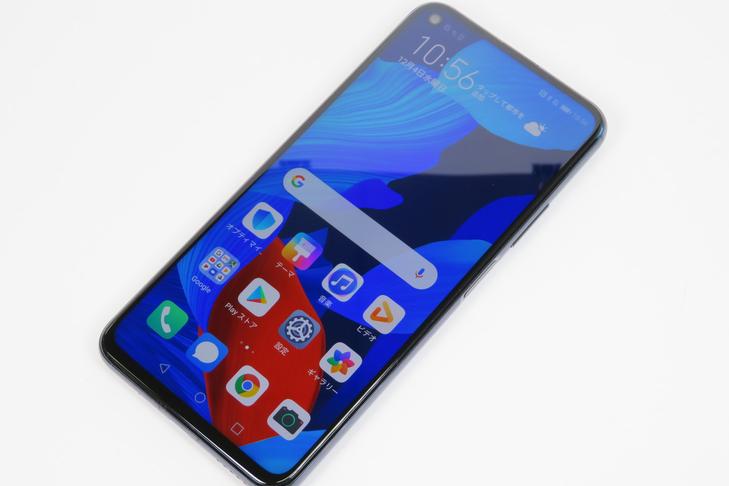Huawei's Wi-Fi router review 10,000 yen cut cost performance strongest? Wi-Fi 6 router "WiFi AX3" review, 160 MHz compatible, 10,000 yen cut cost performance strongest?
The body is compact and stylish, and there are also functions that can be easily connected.
The AX3 is an IEEE 802.11a / b / g / n / ac / ax compliant wireless LAN router. The body color is white and the design is simple. It seems that it can be installed in the living room or bedroom without any discomfort. The main body size is about W131.9 x D225 x H30.9 mm, which is relatively compact for a Wi-Fi 6 compatible router equipped with four external antennas. The antenna at the rear of the main unit is designed to move about 90 ° back and forth, so basically it will be used upright.
A button is provided in the center of the upper surface of the main body. With the push of this button, you can easily connect to a Wi-Fi handset that supports "Huawei HiLink." In addition, it also supports WPS, making it easy to connect to WPS-compatible Wi-Fi handsets (notebook PCs and smartphones).
In addition, NFC is installed in the lower right corner of the upper surface of the main unit, and it also has "Huawei Share" that can be connected by simply touching an NFC-compatible Android smartphone. If this is an NFC-compatible Android smartphone, you don't need a separate application. It will be convenient not only when the family connects the device but also when the visitor such as a friend uses it. However, being able to connect to a router just by touching a smartphone is also a security concern. Huawei Share can be turned off, so if you feel uneasy, we recommend turning it off.
Supports high-speed communication with a width of 160MHz and 2,402Mbps, and has excellent security.
Although it is a wireless LAN specification, both the 2.4GHz band and the 5GHz band are dual bands that support 2 streams (2x2). There are 4 antennas on the outside. By preparing two power amplifiers for each of the 2.4GHz band and the 5GHz band, the radio field strength is enhanced.
The maximum communication speed is 574 Mbps in the 2.4 GHz band and 2,402 Mbps in the 5 GHz band because it supports a bandwidth of 160 MHz. Although the price is less than 10,000 yen excluding tax, the high-speed communication speed (standard value) of up to 2,402 Mbps corresponding to the 160 MHz width in the 5 GHz band is likely to be a big advantage over rival products.
As for the SSID of wireless LAN, the same SSID is used in the 2.4GHz band and 5GHz band as standard, and it is set to connect to the 5GHz band preferentially. Of course, it is also possible to specify and operate individual SSIDs in the 2.4 GHz band and 5 GHz band.
A wired LAN port is provided at the rear of the main unit. It has a total of 4 ports, 1 port for WAN (Internet side) and 3 ports for LAN, all of which are compatible with Gigabit Ethernet.
The main processor is a 1.4GHz quad-core "Gigahome 650". The memory is also relatively large at 256MB, and the recommended number of connected clients is 128, which is a margin. In addition, it supports OFDMA, 2-stream MU-MIMO, and beamforming.
This Gigahome 650 supports Huawei's proprietary "Wi-Fi 6 Plus". Wi-Fi 6 Plus is Huawei's own extension of the specifications while ensuring full compatibility with the standard Wi-Fi 6, and it is said that the effective speed of communication will be increased.
Although the specific mechanism is unknown, it is said that the effective speed has been increased by increasing the utilization efficiency of the wireless band. In particular, it is said that maximum speed will be realized with Wi-Fi 6 Plus compatible clients.
As of August 2020, Huawei's smartphone "P40 Pro 5G" is the only Wi-Fi 6 Plus compatible client (slave unit). When I connected the P40 Pro 5G, I could see the "6+" notation next to the wireless LAN antenna pictogram. This makes it clear that you are connected via Wi-Fi 6 Plus.
The security specifications have acquired the evaluation guarantee level "EAL5" of the international security evaluation standard "CC (Common Criteria)". Normally, it is recommended to obtain "EAL4" for commercial network equipment, but AX3 is a level of certification that exceeds that level, so it is very rich for individuals. In addition, it is equipped with a "Trust Zone" that saves various setting information and user information in an independent secure zone, and a security function "Huawei HomeSec" that automatically recognizes unauthorized access and adds it to the blacklist to block access. It is also characterized by its high security.
In addition, the Wi-Fi encryption method supports the latest WPA3 in addition to WPA / WPA2. It also has basic security functions such as client access restrictions and parental controls.
There are no abundant additional functions like domestic high-performance wireless LAN routers. For example, it does not have a function to connect a storage device such as an HDD to a USB port and use it as a simple file server. You can think of this area as a way to reduce costs.
Unfortunately, it does not support the "IPv6 over IPv4 tunneling (IPv6 IPoE) connection" adopted by Japanese ISPs. Although AX3 itself supports IPv6, it does not support IPv6 IPoE, so high-speed ISP connection services such as v6 Plus, Transix, and OCN Virtual Connect cannot be used. As is often the case with overseas routers, I would like it to be realized by future firmware updates if possible.
It is difficult to confirm the superiority of Wi-Fi 6 Plus, but the effective speed is satisfactory
Now let's check how fast it actually works. IPerf3 was used for speed check.
Start iPerf3 in server mode using ASUS "ExpertBook B9 B9450FA" which is a Wi-Fi 6 compatible notebook PC as a server. And there are two smartphones prepared as clients, the "HUAWEI P40 Pro 5G" compatible with Wi-Fi 6 Plus and the "Galaxy S20 5G" made by Samsung that supports Wi-Fi 6. I accessed iPerf3 set on the server from these two units and verified the speed.

Of course, the wireless LAN connection band uses the 5GHz band. The server PC is connected to AX3 via wired LAN (Gigabit Ethernet). Furthermore, for comparison, a similar test was conducted with the Buffalo Wi-Fi 6 compatible wireless LAN router "WXR-5950AX12". The wireless LAN router, server PC, and client smartphone are all installed in the same room.
Check the link speed of each client before measuring the effective speed. The wireless LAN module installed in the server PC is Intel's "Wi-Fi 6 AX201", which supports 2 streams in the 5GHz band and 160MHz width connection. Actually, I confirmed the link with AX3 at 2.4Gbps.
Next is a smartphone, but the P40 Pro 5G also supports connection with 2 streams in the 5GHz band and 160MHz width, and we also confirmed the link at 2,401Mbps. On the other hand, the S20 5G supports 2 streams in the 5GHz band and connections up to 80MHz width, and the link speed was 1.2Gbps.
Then check the effective speed. In this test, since the server PC is connected to the Gigabit Ethernet wired LAN, it is slower than the wireless LAN link speed, and this is likely to be the bottleneck.
Of course, the test results did not exceed 1 Gbps, but in each case, the speed of Gigabit Ethernet, which is almost the upper limit, can be pulled out. Looking closely at the results, the P40 Pro 5G, which has a faster link speed, was slightly faster than the S20 5G.
Focusing solely on the P40 Pro 5G results, both results are slightly faster when connected to the AX3 than when connected to the WXR-5950AX12. Numerically, it can be said that it is within the margin of error, so it is a little difficult to judge. However, the tendency is that the AX3 is slightly faster than the other, even if it is measured multiple times, so it seems that Wi-Fi 6 Plus is effective.
P40 Pro 5G / Downstream (Mbps)
WiFi AX3: 919
WXR-5950AX12: 903
P40 Pro 5G / Upstream (Mbps)
WiFi AX3: 939
WXR-5950AX12: 883
S20 5G / downlink (Mbps)
WiFi AX3: 826
WXR-5950AX12: 891
S20 5G / Upstream (Mbps)
WiFi AX3: 748
WXR-5950AX12: 825
On the contrary, with the S20 5G, the WXR-5950 AX12 connection was faster than the AX3 connection. The WXR-5950AX12 is a high-end router from Buffalo, and its internal specifications are overwhelmingly richer than the AX3, so it is thought that such a difference has occurred. However, considering that the actual selling price of the WXR-5950AX12 is more than three times higher than that of the AX3, the high cost performance of the AX3 stands out.
However, if the wireless LAN side can still connect at a maximum of 2,402 Mbps, consideration should be given to the AX3's wired LAN side also supporting 2.5GbE and link aggregation that bundles two LAN ports for speeding up. I think. Considering the price of AX3, there are some difficult parts, but if only the wireless LAN side is high speed, it will not be possible to bring out sufficient performance, so I would like to see a product equipped with a high-speed wired LAN port as a high-end model.
Wi-Fi 6 / 160MHz compatible, 10,000 yen excluding tax is exceptional
Among the Wi-Fi 6 compatible routers currently on the market, some entry products for less than 10,000 yen have appeared. However, most of the entry products have 2 streams (80MHz width) in the 5GHz band, and the maximum speed (standard value) is 1,201Mbps.
Under such circumstances, the AX3 is characterized by its overwhelmingly high-speed connection, with a maximum of 2,402 Mbps compatible with 2 streams (160 MHz width) in the 5 GHz band, at a price of 10,000 yen excluding tax. Wired LAN is a bottleneck because it is only Gigabit Ethernet, but the communication speed between clients connected to wireless LAN is definitely advantageous, so this point should be a big advantage over competing products.
Wi-Fi 6 Plus is unlikely to be a significant advantage as there are few compatible clients. Of course, compatibility with Wi-Fi 6 is fine, and you should think about it as a bonus. The functionality is simple, but it covers most of the necessary features and has a lot of security features. It is a pity that it does not support IPv6 IPoE, but even considering that, the cost performance is high. Recommended for those who are looking for a router that can perform high-speed wireless LAN communication at a low cost.





![[July 6 and 7] DX realized by content cloud, advanced platform for business transformation](https://website-google-hk.oss-cn-hongkong.aliyuncs.com/drawing/article_results_9/2022/3/9/6bbafe438d78271513761788166cbf94_0.jpeg)

